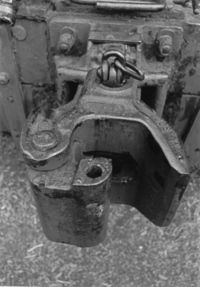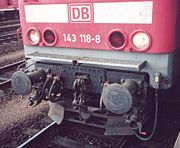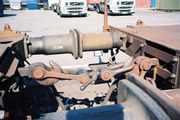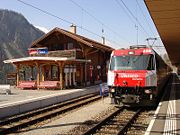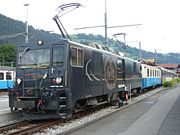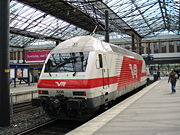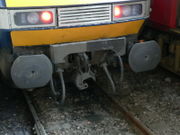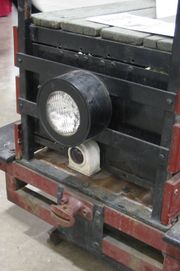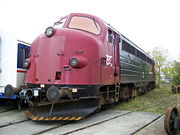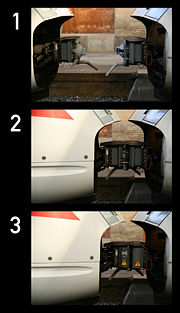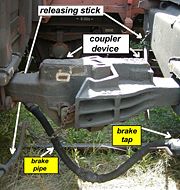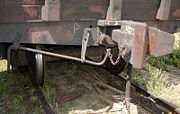Coupling (railway)
2008/9 Schools Wikipedia Selection. Related subjects: Railway transport
A coupling (or a coupler) is a mechanism for connecting rolling stock in a train. The design of these couplings is a standard almost as important as the railway gauge, since flexibility and convenience are maximised if all rolling stock can be coupled together.
Nomenclature
The different types of coupling do not always have formal or official names, which makes descriptions of the couplings in use on any railway system problematic.
Buffers and chain
The standard type of coupling on railways following the British tradition is the buffer and chain coupling used on the pioneering Liverpool and Manchester Railway of 1830. These couplings followed earlier tramway practice but were made more regular. The vehicles are coupled by hand using a hook and links with a turnbuckle-like device that draws the vehicles together. In Britain, this is called a screw coupling. Vehicles have buffers, one at each corner on the ends, which are pulled together and compressed by the coupling device. This arrangement limits the slack in trains and lessens shocks. In contrast, Janney couplers encourage violent encounters in order to engage the coupling fully. The earliest buffers were fixed extensions of the wagon frames, but later spring buffers were introduced.
Inefficient and slow, the European system is relatively unsafe because it requires manual coupling between vehicles, exposing workers to the risk of being crushed. With central couplers (except link and pin) it is not usually necessary to get between the cars for coupling or uncoupling. The safety issue was one of the main arguments for changing to central couplers. After more than 30 years, the change has still not been completed; indeed it has barely started.
This coupling type is the standard in European countries (except the former Soviet Union, where the SA-3 automatic coupler is used). Coupling is done by a worker, who must climb between the cars. First he turns a releasing screw (an aid with two opposite windings, and it does not uncouple the train itself) to the loose position, and then he can hang the chain on the hook. After hanging the chain on the towing hook the releasing screw must be turned to the tight position. When the coupler is uncoupled, it must be hung on the idle hook to prevent damage to itself or the brake pipes. Only shunting is permitted with a dangling chain. Disconnected brake pipes must be hung on hooks. (The picture shows two coupled cars, with a single brake pipe.)
The hooks and chain hold the carriages together, while the buffers keep the carriages from banging into each other so that no damage is caused. The buffers can be "dumb" or spring-loaded. That means there are no run-in forces on the coupler. The other benefit compared with automatic couplers is that its lesser slack causes smaller forces on curves; there is a lower probability of a broken coupler in a curve than with automatic couplers. The disadvantage is the smaller mass of the freight that can be hauled by that coupler (maximum 3000 tonnes).
Early rolling stock was often fitted with a pair of auxiliary chains as a backup if the main coupling failed. This made sense before the fitting of continuous fail-safe braking systems.
On railways where rolling stock always pointed the same way, the chain might be mounted at one end only, as a small cost- and weight-saving method.
On German railways, one buffer is flatter than the other buffer, which is slightly more rounded. This provides better contact between the buffers than would be the case if both buffers were slightly rounded.
Buffers and narrow gauge
With the exception of Queensland and Tasmania, twin buffers and chains are rare on narrow gauge lines, perhaps because of the buffer locking problem on sharp curves.
Three-link couplings
A peculiarly British institution was the "loose-coupled" freight train. This used three-link chain couplings with no means of drawing the wagons together: since such trains were not fitted with an automatic through-train braking system there were no pipes to connect between the vehicles. The couplings in the train were kept taut by the last vehicle of the train being a heavily ballasted guards van with its brakes set slightly on. This helped prevent snapped couplings. Such trains travelled at low speeds and were phased out in the 1970s.
An improvement on this is the "Instanter" coupling, in which the middle link of a three link chain is specially shaped so that when lying "prone" it provides enough slack to make coupling possible, but when this middle link is rotated 90 degrees the length of the chain is effectively shortened, reducing the amount of slack without the need to wind a screw. The closeness of the coupling allows the use of inter-vehicle pipes for train brakes. It also has the advantage that it can be operated entirely from the side of the wagons using a shunter's pole and is therefore safer when shunting work is under way. These couplings are still prevalent in UK freight trains today.
Problems with buffers and chain
The buffers and chain coupling system has a maximum load much less that the Janney coupling. Also, on sharp reverse curves, the buffers can get bufferlocked by somehow getting on the wrong side of the adjacent buffer. An accident at a Swiss station was caused by buffer-locked wagons in the 1980s. The bufferlock could be caused on the very sharp turnouts by the older rounded buffers. The newer buffers has rectangle shape and they are wider than taller. They are not so flat, so they rarely cause buffer locking.
Variation with gauge
The width between the buffers tends to increase as the gauge increases, so that if wagons are changed from one gauge to another, the buffers will no longer match. This occurs because the buffers are originally extensions of the frames, which are spaced according to the gauge.
On some narrow-gauge lines in Europe a simplified version is used, consisting of a single central buffer with a chain underneath. The chain usually contains a screw-adjustable link to allow close coupling. On sharp curves, a single centre buffer is less likely to be subject to buffer locking problem, as described above.
Central buffer'n'under chain
This coupler is used in the Paris Métro (except the lines 1 and 14, because the speed of the MP 89). This subway system is very older, the unique coupler was the buffer'n'chain, so, the trains hads to use this coupler, how? Using the central buffer system, used in metre gauge railroads (but, in 1913, the belgian train builder La Brugeoise mades a special fully automatic coupler for Buenos Aires Metro Line A). In the swiss metric gauge railroad M.O.B. use this coupling system, it's the same RATP's coupling!! Look at the photo.
Dual coupling
It is possible to mount both buffers and chain and knuckle couplers on the same car, provided that one can swing out of the way.
Locomotives and some freight cars of the Indian Railways are fitted with a 'transition coupler' that incorporates a screw coupling within a knuckle coupler: the knuckle coupler remains in position and does not swing away when not in use. The screw coupling is mounted on a lug within the knuckle coupler. See SAB WABCO C-AK. Most Indian freight cars use the knuckle coupler alone, without buffers, whereas passenger coaches almost exclusively use screw couplers and buffers. Exceptions are the new LHB coaches imported from Europe, and a few other makes of carriages converted to use knuckle couplers.
Some Russian locomotives and wagons have buffers together with the central coupler. When coupling to Finnish equipment, a short chain with a block that fits in the central coupler is placed on the Russian side, backing up and compressing the buffers so that the chain can be laid on the hook. (That is also the common way of coupling locomotives to or from wagons, faster than unscrewing the link.)
British locomotive-hauled passenger carriages adopted a dual coupling system in the 1950s. They have retractable buffers and a central Buckeye automatic knuckle coupler that lowers to reveal a hook for a screw-type chain coupling. Inter-stock coupling was with the automatic coupler (with the buffers retracted), while connection to the locomotive was with the buffer-and-chain system with a screw coupler.
Link and pin
The link and pin coupling was the original style of coupling used on American railways, surviving after conversion to Janney couplings on forestry railways. While simple in principle, the link and pin coupling suffered from a lack of standardisation regarding size and height of the links.
The link and pin coupler consisted of a tubelike body that received an oblong link. During coupling, a railworker had to stand between the cars as they came together and guide the link into the coupler pocket. Once the cars were joined, the employee inserted a pin into a hole a few inches from the end of the tube to hold the link in place. This procedure was exceptionally dangerous and many brakemen lost fingers or entire hands when they did not get their hands out of the way of the coupler pockets; many more were killed as a result of being crushed between cars or dragged under cars that were coupled too quickly. Brakemen were issued with heavy clubs that could be used to hold the link in position, but many brakemen would not use the club, and risk injury.
The link and pin coupler proved unsatisfactory because:
- It made a loose connection between the cars, with too much slack action.
- There was no standard design, and train crews often spent hours trying to match pins and links while coupling cars.
- The links and pins were often pilfered (due to their value as scrap metal), resulting in substantial replacement costs. John H. White suggests that the railroads considered this to be more important than the safety issue at the time (see reference below).
- Crew members had to go between moving cars during coupling, and were frequently injured and sometimes killed.
- Eventually, railroads wished to operate trains that were heavier than the link and pin system could cope with.
An episode of the 1960s TV series Casey Jones was devoted to the problems of link and pin couplings.
Norwegian

Norwegian (or meat chopper) couplings consist of a central buffer with a mechanical hook that drops into a slot in the central buffer. The Norwegian is found only on narrow gauge railways, such as the Ffestiniog Railway and the Welsh Highland Railway, where low speeds and reduced train loads allow a simpler system. On railway lines where rolling stock always points the same way, the mechanical hook may be provided only on one end of each wagon. This was the situation on the Lynton & Barnstaple (L&B), a narrow gauge line in Devon, England, and still applies to railways in New Zealand. Similarly, the hand brake handles may also be on one side of the wagons only.
Norwegian couplings are not particularly strong, and may be supplemented by auxiliary chains. The L&B originally used side chains in conjunction with Norwegian couplers, but these were found to be unnecessary with the slow speeds employed (10-15 miles per hour) and were removed within a year or so of the line opening in 1898.
The Pichi Richi Railway in South Australia uses Norwegian couplers as its standard, and converts Janney coupler to Norwegian as required. The slot in the "buffer beam" where the coupler protrudes appears to be about the same for both types of couplers. As a museum, it is appropriate to use the older type of coupling.
Not all Norwegian couplings are compatible with one another as they vary in height, width, and may or may not be limited to one hook at a time.
Automatic couplers
There are a number of automatic train couplings, most of which are mutually incompatible.
- AAR ( American Association of Railroads) coupler (also known as knuckle coupler and once known as Janney coupler, alliance coupler, see below) used in Canada, the USA, Mexico, Japan, Australia, South Africa, Saudi Arabia, Cuba, Chile, Brazil, China and elsewhere.
- Maximum tonnage as high as 32,000 t. such as Fortescue Railway.
- The AAR (Janney) couplers comes in at least two sizes, "full size" and "three quarter", which are not compatible. Lighter weight railways, especially those of narrow gauge or with no need for interrunning sometimes use smaller (3/4 or half size) versions of the AAR coupling.
- AAR couplers are always right-handed.
- AAR are not necessarily mounted at the same height above rail - some variation can be tolerated.
- AAR couplers are uncoupled by lifting the coupling pin with a lever at the corner of the car. This pin is locked when the coupler is under tension, so the usual uncoupling steps are to compress the coupling with a locomotive, lift and hold up the pin, then pull the cars apart. Side operated variants are called the "Sharon coupler" or "Buckeye coupler" .
- Trains fitted with AAR couplers can have heavier loads than any other type of coupler. Thus the heaviest coal trains in New Zealand have AAR couplings even though the remainder of the fleet has the meatchopper kind. Also, long-distance freight trains in North America are quite commonly more than a mile (1.6 km) long, whereas this is unknown in Europe, where most freight trains still use the buffers and chain system.
- See also "Janney Coupler" and "changes since 1873" below.
- Russian SA3 coupler , also known as a " Willison Coupler with a Russian contour", (somewhat similar to Janney) used in Russia, former Soviet Union, Finland, Mongolia, Iraq and on Malmbanan, Sweden. See also: Animation showing SA3 coupling (site in Russian)
- Russian trains are rarely longer than about 750 m and rarely exceed a maximum tonnage about 6,000 t, so it is not clear what potential load these couplings are capable of.
- The effort to break the SA-3 coupler is about 300 t.
- Malmbana trains are about 8,000T.
- European proposal coupler , (compatible with the Russian coupler) with automatic air, control and power connections. Implementation permanently delayed except for a few users.
- Scharfenberg coupler used on electric passenger trains - connects brake and controls. See Fully Automatic Couplings below.
- Maximum tonnage under 1,000 t.
- Note: There are a number of other automatic train couplings similar to the Scharfenberg coupler, but not necessarely compatible with it. Older US transit operators continue to use these non-Janney electro-pneumatic coupler designs and have used them for decades.
Janney coupler
Later Master Car Builders Association coupler, now AAR ( American Association of Railroads) coupler, see also AAR coupler above.
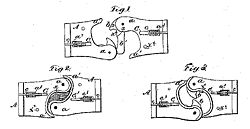
Janney couplings are always right-handed.
The knuckle coupler or Janney coupler was invented by Eli H. Janney, who received a patent in 1873 (). It is also known as a "buckeye coupler", notably in the United Kingdom, where some rolling stock (mostly for passenger trains) is fitted with it. Janney was a dry goods clerk and former Confederate Army officer from Alexandria, Virginia, who used his lunch hours to whittle from wood an alternative to the link and pin coupler.
In 1893, satisfied that an automatic coupler could meet the demands of commercial railroad operations and, at the same time, be manipulated safely, the United States Congress passed the Safety Appliance Act. Its success in promoting switchyard safety was stunning. Between 1877 and 1887, approximately 38% of all railworker accidents involved coupling. That percentage fell as the railroads began to replace link and pin couplers with automatic couplers. By 1902, only two years after the SAA's effective date, coupling accidents constituted only 4% of all employee accidents. Coupler-related accidents dropped from nearly 11,000 in 1892 to just over 2,000 in 1902, even though the number of railroad employees steadily increased during that decade.
When the Janney coupling was chosen to be the American standard, there were 8000 patented alternatives to choose from.
The only significant defect of the AAR (Janney) design is that sometimes the drawheads need to be manually aligned.
Changes since 1873
The AAR coupler has stood the test of time since its invention, and has seen only minor changes:
- It is clear that the original Janney coupler is no longer compatible with the latest AAR couplers. A visual comparison between the original Janney contour and the current AAR contour (see the illustration of the "Diagram of the top view of Janney's coupler..." and the photograph of the "Knuckle couplers in use" elsewhere in this article) would strongly indicate that the original Janney contour and the current AAR contour (especially that of the knuckle itself) are no longer compatible. The current AAR contour dates back to the " Master Car Builders Association (MCBA)" coupler.
- Buckeye coupler, a side operated version of the MCBA coupler
- Type "E" coupler, the original (plain) AAR coupler, derived from the Master Car Builders Association coupler.
- Type "F" coupler, a "Tooth and socket" variation to prevent accidents, derailments and wrecks from uncoupling the couplers. The "tooth" on a loose coupler could puncture any tank car or other car carrying hazardous materials. Variations on the AAR type "F" coupler have been devised to provide extra protection, in case of derailments and train wrecks, to cars routinely carrying sensitive or hazardous loads. These variations of type "F" couplers, generally involving "shelves", remain fully compatible with standard AAR couplers, but tend to keep derailments and collisions from uncoupling the cars (thereby preventing the "tooth" of the couplers from piercing the ends of the cars).
- The APTA (former AAR) standard type "H" coupler, a "Tooth and socket" variation used mostly, if not exclusively, on passenger cars. Types "F" and "H" couplers are also known as tightlock couplings. The Type "H" coupler is now under the supervision of the APTA ( American Public Transportation Association)
- "pads" to reduce slack on passenger trains.
- improvement to castings, etc. to increase maximum trailing load.
- rotating-shaft couplers (type "F") introduced for use in rotary car dumpers such as on the Pilbara railways.
- narrow gauge railways such as the Victorian Puffing Billy Railway use a miniature version of the AAR coupler.
Fully automatic couplings
Fully automatic couplings are those that make all connections between the rail vehicles (mechanical, air brake and electrical) without human intervention, in contrast to autocouplers which just handle the mechanical aspects. The majority of trains fitted with these types of couplers are multiple units, especially those used in mass transit operations.
There are a few designs of fully automatic couplers in use worldwide, including the Scharfenberg coupler, various knuckle hybrids (such as the Tightlock, used in the UK), the wedgelock coupling, Dellner couplings (similar to Scharfenberg couplers in appearance), and the BSI coupling.
Older US transit operators use non-Janney electro-pneumatic coupler designs that have been in service for decades.
Scharfenberg coupler
The Scharfenberg coupler (German: Scharfenbergkupplung or Schaku) is probably the most commonly used type of fully automatic coupling. Designed in 1903 by Karl Scharfenberg in Königsberg, Germany (today Kaliningrad, Russia), it has gradually spread from transit trains to regular passenger service trains, although outside Europe its use is generally restricted to mass transit systems. The Schaku coupler is superior in many ways to the AAR (Janney/Knuckle) coupler because it makes the electrical and also the pneumatic connections and disconnections automatic. However there is no standard for the placement of these electro-pneumatic connections. Some rail companies have them placed on the sides while others have them placed above the mechanical portion of the Schaku coupler. The main disadvantage to the Scharfenberg coupler is its low maximum tonnage, which makes it highly unsuitable for freight operations.
Small air cylinders, acting on the rotating heads of the coupler, ensure the Schaku coupler engagement, making it unnecessary to use shock to get a good coupling. Joining portions of a passenger train can be done at very low speed (less than 2 mph/3.2 km/h in the final approach), so that the passengers are not jostled about. Rail equipment manufacturers such as Bombardier offer the Schaku coupler as an option on their mass transit systems and their passenger cars and locomotives. In North America all the trains of the Montreal Metro are equipped with it, as are new light rail systems in Denver, Baltimore and New Jersey. It is also used on light rail vehicles in Portland, Minneapolis, the Vancouver Skytrain, and the Scarborough RT in Toronto.
Dual couplings and match wagons
If a wagon with one coupling system needs to be coupled to wagons with another coupling type there are four solutions. This may be needed when taking metro rolling stock from its manufacturer to the city where it is to be used:
- hope that dual fitment of the couplings is possible.
- use a match wagon(s) which have different couplings at either end.
- use a coupling adaptor.
- for emergency use only and for only one wagon at a time, use a rope. Also useful if a coupler is damaged or broken off.
Only some kinds of couplings coexist on the end of a wagon at the same time, because amongst other reasons they need to be at the same height. For example, in the Australian state of Victoria, engines had the AAR coupler, with buffers, and the chain mounted on a lug cast into the AAR coupler.
A match wagon or match truck (also known as a barrier vehicle / wagon in Britain) has different kinds of couplings at each end. If a pair of match wagons is used, a rake of wagons using coupling A can be inserted into a train otherwise using coupling B.
A coupling adaptor might couple to an AAR coupling on a wagon, and present, for example, a meatchopper coupler to the next wagon. Such an adaptor might weigh 100 kg.
Sets of carriages
Automatic couplers like the Janney are safer in a collision because they help prevent the carriages telescoping. British Rail therefore decided to adopt a Janney variant for its passenger carriages, with the coupler able to swing out of the way for coupling to engines with the traditional buffer and chain system.
In New South Wales, sets of carriages were permanently coupled with a fixed bar, since the carriages were disconnected only at the workshops. Freight cars are sometimes coupled in pairs or triplets, using bar couplings in between.
Articulated sets of carriages or wagons share the intermediate bogies, and have no need for couplings in the intermediate positions.
Coupler conversion
From time to time, a railway decides that it needs to upgrade its coupling system from one that is proving unsatisfactory, to another that meets future requirements. This can be done gradually, which can create lots of problems with transitional incompatibilities, or overnight, which requires a lot of planning.
Japan
Japan converted its British-derived buffer and chain couplings to the American Janney coupling over a period of a few days in the early 1920s, after considerable preparation. Today, most (if not all) EMUs including high-speed Shinkansen trains, and some DMUs use the Shaku-Thomlinson type coupling system, while locomotive-hauled trains still use the Janney coupling and Tightlock coupling system.
Australia
Australia, with its break of gauge, has always had different couplers on different systems, and has generally adopted gradual conversion. Conversion to the Janney coupling is now virtually complete. Commonwealth Railways started with Janney couplings on its standard gauge Trans-Australian line, and some railways, like the former Victorian Railways and the Queensland Rail, used dual couplers. Older couplers remain on Heritage railways.
Europe
While Europe has chosen an automatic coupler compatible with the Soviet one, except for some trial installation, no action has been taken to implement the conversion, due to cost. In many heavy-haul applications, such as coal and iron ore, either US AAR-type couplers or Soviet SA-3 couplers are used. Conversion is made harder to justify because the existing buffer and chain coupling is almost universal.
America
Once Congress passed a law mandating conversion from the link and pin coupler to the Janney coupler, railroads in the United States had only a few years to implement the change. The railroads in North America form one unitary system, and uniformity of couplers is important for smooth interchange of rolling stock.
Latin America
Railways in Central and South America are fragmented by gauge, geography, and financial and technical heritage. While some systems have adopted the American Janney coupler, others retain the British buffer and hook (buffer and chain) coupler (see above).
Soviet Union and successor states
Russia and Central Asia used buffer and chain couplings, albeit with possibly wider centres for the buffers, until conversion to automatic SA-3 couplers. The SA-3 coupler was invented in 1932. Some wagons were equipped with SA-3 couplers in the 1930s (they could be coupled with chain coupling), but all cars have received automatic couplers in the 1960s and 1970s. See also: Intermat/Willison coupler, Animation showing SA3 coupling, ru:Автосцепка СА-3 (in Russian)
Middle East
While the Middle East is mostly standard gauge, three different couplings appear to be in use (not counting Sharfenberg couplings on EMU trains). These are buffer-and-chain, American, and Russian types. The proposed UAR standard appears to be the American type.
Africa
South of the Sahara, Janney and chopper couplings (not necessarily of compatible types) appear to account for most couplings. The preferred UAR standard is the American Janney coupling.
Brake couplings
Couplings are needed for any continuous braking systems.
Electronically Controlled Brakes
Electronically Controlled Pneumatic brakes ( ECP) need a method of connecting electrically adjacent wagons, both for power and for command signals, and this can be done by plugs and sockets, or by very short range radio signals.
Models
On model railroads couplers vary according to scale, and have evolved over many years. Early model trains were coupled using various hook-and-loop arrangements, which were frequently asymmetrical, requiring all cars to be pointing in the same direction. In the larger scales, working scale or near-scale models of Janney couplers were quite common, but proved impractical in HO and smaller scales.
For many years, the "X2F" or "Horn-Hook" coupler was quite common in HO scale, as it could be produced as a single piece of moulded plastic. Similarly, for many years, a "lift-hook" coupler developed by Arnold, a German manufacturer of N-scale model trains, was commonly used in that scale.
The chief competitor of both these couplers, more popular among serious modellers, was the Magne-Matic, a magnetically-released knuckle coupler developed by Keith and Dale Edwards, and manufactured by Kadee, a company they started. While they closely resemble miniature Janney couplers, they are somewhat different mechanically, with the knuckle pivoting from the centre of the coupler head, rather than from the side. A steel pin, designed to resemble an air brake hose, allows the couplers to be released magnetically; the design of the coupler head prevents this from happening unless the train is stopped or reversed with a mated pair of couplers directly over an uncoupling magnet. Once the Kadee patents ran out, a number of other manufacturers began to manufacture similar (and compatible) couplers.
Recently, an exact-scale HO model of the AAR coupler has been designed and manufactured by Frank Sergent, of Sergent Engineering. This design uses a tiny stainless steel ball to lock the knuckle closed. Uncoupling is achieved by holding a magnetic wand over the coupler pair to draw the balls out of the locking pockets.
In British 00 scale (similar to H0 scale) models the 'tension lock' coupler is standard. This is similar in operation to the meatchopper type of coupling. While it works well, it is often seen as ugly and obtrusive (although smaller designs are available, these are not always fully compatible with other models) and many British modellers prefer to retrofit either Kadee types or working hook and chain couplings.

